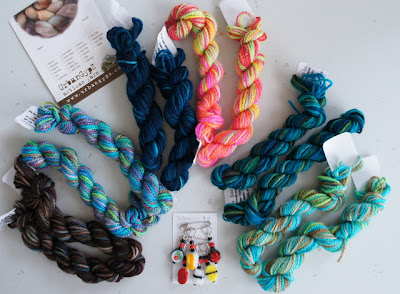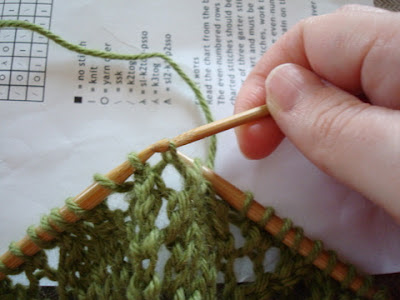Click now for JiffNotes
So when I finished Leafy (aka Branching Out), I never did give it a good glamour shoot.
This isn't one, either, but I did want to share some lessons I learned during the process.
This was the first real lace project I started, so I was pretty much a lace idiot at the beginning. Maybe talking about my mistakes will help someone out there avoid the same thing.
Lesson One: It's all about YO
So what happens when you get to the end of a row, and although you have symbols left on the chart, you have no stitches remaining on the left needle with which to knit them??
PANIC! THROW THE KNITTING ACROSS THE ROOM! TEAR YOUR HAIR OUT!!! ZOMIGOSH, NOOOOOOOO!!!
Ahem. You have to CALMLY figure out where you went wrong. Now, I have some chart-reading notes later that may help you avoid this happenstance. But I found that in my case, the problem almost ALWAYS was that I forgot to do a yarn-over somewhere.
Since this design is vertically symmetrical, it's usually pretty easy to tell where you missed it:
Mmm hmmm...should be a YO stitch on either side of that center line, between it and the leaves. Since this pattern is just purls on the wrong side, this is really easy to fix.
In fact, it's so basic that I almost didn't do this post, but then I thought...
HEY, remember the first time you fixed a YO? You were so stinkin' impressed with yourself! Like it was a big deal!
Well. It WAS a big deal at the time. It arose from much thinking and consternation rather than Googling. So maybe I can save you some of that consternation.
Let's clarify here. Two rows before this one, where I've frogged back halfway, I missed a yarn over. One row before this one, a purl row, I would have purled that YO and ended up with a stitch on the needle where there is no stitch right now. It would have looked just like the one to the left of the center line, like so (click to embiggen):
This mistake is almost as easy to fix as it is to make. We're going to pick up a "bar" between two stitches with a small crochet hook, catch another bar, and put that
second bar on the needle. The stitch circled in purple (the "second bar") is going to end up on the needle.
But we can't just pick that up and put it on the needle; that'd be like we did a YO on the purl row. So we'll put our hook in UNDER the PINK-circled stitch, or bar (the purple one's now resting on my left-hand ring finger)...
...hook the purple stitch from the front...
...and pull the purple one through!
Stick it on the left needle, and we're ready to knit!
Now this stitch, the center stitch, and the one to the left of center participated in a 2-stitch centered decrease (or slip 2 tog, knit 1, pass slipped stitches over), so I won't show that. But here's the fixed, symmetrical row:
Notice that this time I remembered the YO on either side of that center stitch.
Lesson Two: Throw yourself a Lifeline
So I'd heard about this nifty concept called a "lifeline" and even though I am perfect and would never need to rip back (BWAHAHAHA), I thought that if a lifeline was good enough for Regis Freakin' Philbin, it was good enough for me. So I pulled out some pearl cotton and a large tapestry needle and put one in, thusly:
This is actually a Chibi needle with a bent tip; great for sliding under the stitches. Thread it all the way across, being careful not to go through any yarn strands, and leave a 3-4 inches hanging on either side. Then on the next row, pretty much ignore that lifeline and knit as usual...just don't let it pop up over the needle while you're knitting. You want it to stay "in" the stitch where you threaded it.
Here's the lifeline after one row is knit:
PRO TIP: Write down what row you put the lifeline in! Otherwise it's slightly less useful.
I have since heard the BEST tip. If you're using interchangeable needles with that little hole through the shaft, you can just thread your pearl cotton (or similar fiber) through that hole, knit across the row,
et voilà, your lifeline is threaded!
So what's it good for? OMIGOSH, I MADE A MISTAKE (i.e., Heather missed a YO) FIVE ROWS BACK! To pull up the stitch, I'd have to somehow pull it through a k2tog, a p, and a sl2-k-psso among other things?? HEAD EXPLODES.
No. You probably can't just "pull up" that missing YO if it's that far back. This is more likely to happen earlier in the lace, when you just have a chart and a few rows of lace that don't "look like" anything. Once pattern understanding happens, you'll likely have caught that mistake earlier (see lesson three). So, if you have a lifeline, you do a slightly-less-scary-but-still-unnerving thing instead:
You take your needle out and gleefully pull on that loose yarn until you hit pearl cotton!
WHEEEEE!!!!
Then you put it all back on the needles. I did take some pictures of this; let me know if you're interested in seeing them. Remember when you wrote down what row the lifeline was in? YOU DID DO THAT, RIGHT?? Good. Now just start knitting from there. I moved my lifeline every repeat, religiously, until I "understood" the pattern.
Lesson Three: Respect your ancestors
So what is this "understanding" the pattern you speak of? Well, for me, it has to do with two things: 1) knowing "where" you are in the lace while knitting across a row (for example, in this pattern, knowing that k3tog is making the top of a leaf, or knowing I'm in the center, and there should be a center vertical line going alllll the way up the design) and 2) knowing what stitches you are knitting.
DUH, you say,
How can I knit a stitch without knowing what I'm kniting?
Let me explain #2. It's not the stitch you're creating, it's the stitches you're creating it WITH. Stay with me here. If I'm doing a k3tog, it matters very much what 3 I'm k-ing tog. If I'm
supposed to be knitting a YO, k and a YO together, and I am actually knitting two k's and a k2tog, that probably means I missed doing two YOs! If I catch it at that point, rather than when I "run out" of stitches at the end of the row, or, heaven forfend, FIVE ROWS LATER, it's much easier to fix.
Here is where the chart can help you. You should be able to look at that k3tog you're doing and see from the chart what it's made up of. It's also helpful if the chart kind of "looks" like the lace you're knitting. The chart provided with this pattern wasn't helping me...I couldn't "see" the leaves. So I recharted it. (Disclaimer: I don't own
this design, and this chart won't make that much sense to you without it, so
go get it here! You're welcome to print this chart out or link to it so long as you don't claim it as your own. ALSO NOTE: I wrote the directions for sl2, k1 , psso WRONG in the key. IGNORE IGNORE IGNORE.)

See? Now you can sort of see the leaves. Now take a look at the k3tog at the right side (beginning) of row 7. If you look down two rows (my chart includes the WS purl rows) and look at the symbol immediately below it, and the two symbols to the right and left, you can see that I should be knitting together a ssk, YO, and another k3tog. Now maybe you can't tell the different between a ssk and a k3tog (like I couldn't when I was knitting this). BUT you can definitely tell the difference between a ssk and a k. Or a YO. If what you're knitting together doesn't look right, figure out where you went wrong NOW! This pattern may only be like 25 stitches across...but what if you were doing one that was 125 across! (I also like to mark "repeat" sections when I'm working lace...at least until I can see the pattern and then check each repeat.)
I hope this helps someone!























































